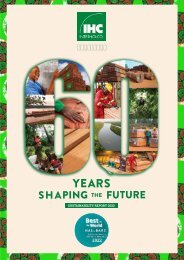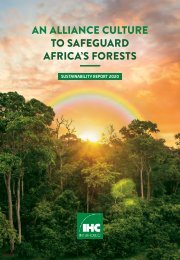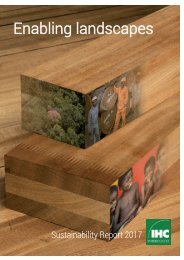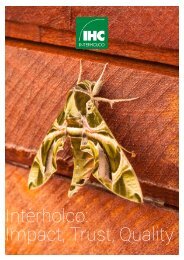Nomenclature Générale des Bois Tropicaux - 7ème édition
(english description below) Cette nomenclature est utilisée pour la mise à jour du 'Harmonized Code System' de l’Organisation Mondiale des Douanes. Dans la circulaire du 5 avril 2005, le Ministère de l’Economie, des Finances et de l’Industrie (France) reconnaît l’ATIBT comme « gardien du temple » de la nomenclature des bois tropicaux. La Commission Européenne mentionne la nomenclature de l’ATIBT comme document de référence pour la mise en œuvre du RBUE. Depuis 1954, l’ATIBT a établi et mis à jour une nomenclature des bois tropicaux faisant correspondre chaque espèce botanique avec un nom pilote reconnu internationalement. La détermination du nom pilote d’une essence est cruciale, car sa commercialisation dépend très largement de l’adoption de ce nom par le public. Le nom pilote assure la protection de l’appellation commerciale de l’essence et l’intégrité des propriétés qui lui sont attribuées, sans risque de confusion. The 1982 version of the general timber nomenclature has finally been updated as some of the 1,750 identified species, are no longer traded, while others, which were not previously included, are now on the market. The present revision has also integrated changes related to new taxonomy, in order to reflect the latest scientific developments. This Nomenclature has been used for the Harmonized Code System, updated by the World Customs Organization. The French Ministry of economy, finance and industry has given official recognition to ATIBT as the reference for the tropical timber nomenclature (NOR: PRMX0508285C of April 5th 2005). The European Commission refers to ATIBT nomenclature as a reference document for the implementation of the EUTR regulation. Since 1954, ATIBT has established and updated a nomenclature of tropical wood, linking each botanical species with an internationally recognized pilot name. A sigle wood species may have many common names; when trading across different countries, this may lead to confusion. Fixing the pilot name of a timber species is crucial, to protect the commercial denomination of the species and guarantee the veracity of the properties linked to that species, without confusion.
(english description below)
Cette nomenclature est utilisée pour la mise à jour du 'Harmonized Code System' de l’Organisation Mondiale des Douanes. Dans la circulaire du 5 avril 2005, le Ministère de l’Economie, des Finances et de l’Industrie (France) reconnaît l’ATIBT comme « gardien du temple » de la nomenclature des bois tropicaux. La Commission Européenne mentionne la nomenclature de l’ATIBT comme document de référence pour la mise en œuvre du RBUE.
Depuis 1954, l’ATIBT a établi et mis à jour une nomenclature des bois tropicaux faisant correspondre chaque espèce botanique avec un nom pilote reconnu internationalement. La détermination du nom pilote d’une essence est cruciale, car sa commercialisation dépend très largement de l’adoption de ce nom par le public. Le nom pilote assure la protection de l’appellation commerciale de l’essence et l’intégrité des propriétés qui lui sont attribuées, sans risque de confusion.
The 1982 version of the general timber nomenclature has finally been updated as some of the 1,750 identified species, are no longer traded, while others, which were not previously included, are now on the market. The present revision has also integrated changes related to new taxonomy, in order to reflect the latest scientific developments.
This Nomenclature has been used for the Harmonized Code System, updated by the World Customs Organization. The French Ministry of economy, finance and industry has given official recognition to ATIBT as the reference for the tropical timber nomenclature (NOR: PRMX0508285C of April 5th 2005). The European Commission refers to ATIBT nomenclature as a reference document for the implementation of the EUTR regulation.
Since 1954, ATIBT has established and updated a nomenclature of tropical wood, linking each botanical species with an internationally recognized pilot name. A sigle wood species may have many common names; when trading across different countries, this may lead to confusion. Fixing the pilot name of a timber species is crucial, to protect the commercial denomination of the species and guarantee the veracity of the properties linked to that species, without confusion.
You also want an ePaper? Increase the reach of your titles
YUMPU automatically turns print PDFs into web optimized ePapers that Google loves.
50 ///
Nomenclature générale des bois tropicaux 2016
Liste des noms pilotes des bois tropicaux avec renvoi aux noms scientifiques
et aux différents noms vernaculaires
List of pilot names of tropical hardwoods with reference to the scientific
names and its differents common names
PILOT NAME BOTANICAL NAMES COMMON NAMES
Abarco Cariniana pyriformis Miers Abarco (CO) ; Bacu (VE)
Abura
Acacia
Fleroya ledermannii Y.F. Deng
(Syn. Fleroya ledermannii)
Fleroya rubrostipulata Y.F. Deng
(Syn. Hallea rubrostipulata)
Fleroya stipulosa Y.F. Deng
(Syn. Hallea stipulosa)
Acacia auriculiformis A. Cunn.
Acacia mangium Willd.
Acacia spp.
Açacu Hura crepitans L.
Acajou Cailcedrat
Acajou d’Afrique
Khaya senegalensis A. Juss.
Khaya anthotheca C. DC.
Khaya grandifoliola C. DC.
Khaya ivorensis A. Chev.
(Syn. Khaya klainei)
Acajou Umbaua Khaya nyasica Stapf Acajou Umbaua (MZ)
Adjouaba
Afina
Afrormosia
Aiélé
Aiéouéko
Akak
Dacryodes klaineana H.J. Lam
(Syn. Pachylobus deliciosus)
Strombosia glaucescens Engl.
Strombosia pustulata Oliv.
Pericopsis elata Meeuwen *
(Syn. Afrormosia elata)
Canarium schweinfurthii Engl.
Dimorphandra polyandra Benoist
(Syn. Dimorphandra hohenkerkii)
Dimorphandra spp.
Duboscia macrocarpa Bocq.
Duboscia viridiflora Mildbr.
Abura (NG) ; Agbantin (BJ) ; Bahia (CI) ; Elelom
(CM) ; Elelom-N’Zam (GA) ; Elelon (GQ) ; Mboi
(SL) ; Mivuku (AO, CD) ; Nzingu (UG, ZM) ; Oro
(CF) ; Subaha (GH) ; Vuku (CG)
Arr (PG) ; Black Wattle (AU) ; Kayu Safoda (MY) ;
Kra Thin Tepa (TH) ; Mangge Hutan (ID) ; Brown
Salwood (AU) ; Tongke Hutan (ID)
Açacu (BR) ; Assacù (BR) ; Bois du diable (GF) ;
Catahua (PE) ; Ceiba habillo (VE) ; Ceiba lechosa
(CO) ; Habillo (EC) ; Jabillo (VE) ; Ochoho (BO) ;
Possentrie (SR) ; Possum (SR) ; Sablier (GF) ; Sandbox
(GY) ; Ura Wood (SR)
Abgo (BJ) ; Acajou Bissilom (ML) ; Acajou Cailcedrat
(BJ, CI) ; Bissilom (GW, SN) ; Diala (GN) ; Zunzatin
(BJ)
Acajou Bassam (CI) ; Acajou blanc (CI) ; African
Mahogany (GH) ; Ahafo (GH) ; Akuk (NG) ; Benin
Mahogany (NG) ; Caoba del Galon (GQ) ; Déké
(CF) ; Eri Kire (UG) ; Kaju (BJ) ; Krala (CI) ; Mangona
(CM) ; Munyama (UG) ; N’Dola (AO, CG) ;
N’Gollon (CM) ; Ogwango (NG) ; Takoradi Mahogany
(GH) ; Undia Nunu (AO) ; Zamanguila (GQ) ;
Zaminguila (GA)
Adjouaba (CI)
Itako (NG) ; Otingbo (NG) ; Poe (CI)
Afrormosia (GH) ; Assamela (CI) ; Bohala (CD) ;
Bohele (CD) ; Kokrudua (GH) ; Mohole (CD) ;
Obang (CF, CG, CM) ; Ole (CD)
Abe (GQ) ; Abel (CM) ; Abeul (GA) ; Aiélé (CI) ;
Bediwunua (GH) ; Bidikala (CD) ; Billi (SL) ; Elemi
(NG) ; Eyere (GH) ; Gberi (CF) ; M’Bidikala (CD) ;
M’Bili (AO, CG) ; Mwafu (UG) ; Ovili (GA)
Aiéouéko (GF) ; Anjama (SR) ; Dakama (GY)
Akak (CM)














